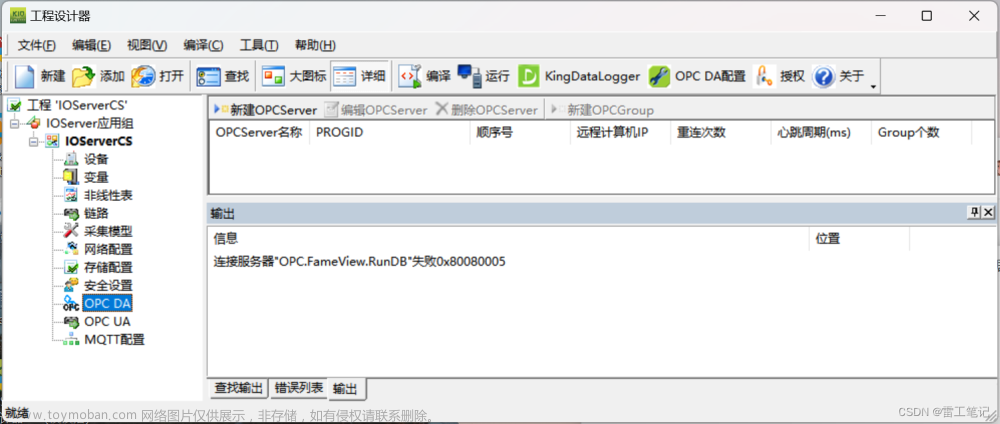前言
OPC UA与OPC DA协议常见于工业生产中使用,例如煤矿的综采支架电液控系统。OPC UA 是OPC 的后继标准,只是后面增加了UA ,意指”统一架构”(Unified Architecture).它的主要目的是摆脱windows! 实现与平台无关的OPC.从OPC 演进到OPC UA,它的目的并没有改变,依然是为了实现分布式控制系统中的分布式对象技术.但是它的方式变成了与平台无关.面向了开放系统.这也就意味着我们可以在一个Arm /linux平台上实现OPC 的server,或者在云端linux平台上实现Client 程序.
一、读取数据前的确认事项
目前,大部分OPC UA协议都会使用Kepserver EX6作为服务器端,当我们作为客户端去读取服务器端的数据时,必须确保服务器与客户端配置的匹配。
1: 服务器端与客户端必须保持网络通畅,这是最基本的要求。
2:确认服务器的IP地址与开放的端口号。
3:确认服务器端的安全策略,是否需要密码等。
二、具体步骤
1.与服务器连接
代码如下(C#为例):
try
{
// Create the configuration.
ApplicationConfiguration configuration = Helpers.CreateClientConfiguration();
// Create the endpoint configuration (use the application configuration to provide default values).
EndpointConfiguration endpointConfiguration = EndpointConfiguration.Create(configuration);
// The default timeout for a requests sent using the channel.
endpointConfiguration.OperationTimeout = 300000;
// Use the pure binary encoding on the wire.
endpointConfiguration.UseBinaryEncoding = true;
// Create the endpoint.
ConfiguredEndpoint endpoint = new ConfiguredEndpoint(null, endpointDescription, endpointConfiguration);
// Create the binding factory.
BindingFactory bindingFactory = BindingFactory.Create(configuration);
X509Certificate2 clientCertificate = configuration.SecurityConfiguration.ApplicationCertificate.Find();
// Set up a callback to handle certificate validation errors.
configuration.CertificateValidator.CertificateValidation += new CertificateValidationEventHandler(CertificateValidator_CertificateValidation);
// Initialize the channel which will be created with the server.
SessionChannel channel = SessionChannel.Create(
configuration,
endpointDescription,
endpointConfiguration,
bindingFactory,
clientCertificate,
null);
// Wrap the channel with the session object.
// This call will fail if the server does not trust the client certificate.
m_Session = new Session(channel, configuration, endpoint);
m_Session.ReturnDiagnostics = DiagnosticsMasks.All;
// Register keep alive callback.
m_Session.KeepAlive += new KeepAliveEventHandler(Session_KeepAlive);
UserIdentity identity = new UserIdentity();
// Create the session. This actually connects to the server.
// Passing null for the user identity will create an anonymous session.
m_Session.Open("OPC UA client", identity);
return m_Session;
}
catch (Exception e)
{
throw e;
}
2.读取所有节点
代码如下(示例):文章来源:https://www.toymoban.com/news/detail-617559.html
public ReferenceDescriptionCollection BrowseNodes(NodeId sourceId)
{
m_Session = this.MySession;
if (m_Session == null){return null;}
// fetch references from the server.
// find all of the components of the node.
BrowseDescription nodeToBrowse1 = new BrowseDescription();
nodeToBrowse1.NodeId = sourceId;
nodeToBrowse1.BrowseDirection = BrowseDirection.Forward;
//nodeToBrowse1.ReferenceTypeId = ReferenceTypeIds.Aggregates;
nodeToBrowse1.ReferenceTypeId = ReferenceTypeIds.HasChild;
nodeToBrowse1.IncludeSubtypes = false;
//nodeToBrowse1.NodeClassMask = (uint)(NodeClass.Object | NodeClass.Variable);
nodeToBrowse1.NodeClassMask = (uint)(NodeClass.Variable);
nodeToBrowse1.ResultMask = (uint)BrowseResultMask.All;
Browser bro = new Browser(m_Session);
ReferenceDescriptionCollection references = bro.Browse(sourceId);
return references;
}
获取指定节点下的引用
private ReferenceDescriptionCollection getTargetItemList(ReferenceDescriptionCollection references, string targetStr)
{
ReferenceDescriptionCollection retrunRef = new ReferenceDescriptionCollection();
foreach (ReferenceDescription rf in references)
{
if (!targetStr.Equals("item"))
{
if (!rf.DisplayName.ToString().StartsWith(@"_") && targetStr.Equals(rf.DisplayName.ToString()) && rf.BrowseName.ToString() != "FolderType")
{
retrunRef = BrowseNodes((NodeId)rf.NodeId);
break;
}
}
else
{
if (!rf.DisplayName.ToString().StartsWith(@"_") && rf.DisplayName.ToString() != "FolderType")
{
retrunRef.Add(rf);
}
}
}
return retrunRef;
}
读取数据
public ResponseHeader ReadValues(
NodeIdCollection nodesToRead,
out DataValueCollection results)
{
ResponseHeader response = null;
results = null;
DiagnosticInfoCollection diagnosticInfos;
// build list of attributes to read.
ReadValueIdCollection valueIdsToRead = new ReadValueIdCollection();
try
{
for (int i = 0; i < nodesToRead.Count; i++)
{
ReadValueId attributeToRead = new ReadValueId();
attributeToRead.NodeId = nodesToRead[i];
attributeToRead.AttributeId = Attributes.Value;
attributeToRead.Handle = attributeIdToString(Attributes.Value);
valueIdsToRead.Add(attributeToRead);
}
response = m_Session.Read(
null,
0,
TimestampsToReturn.Both,
valueIdsToRead,
out results,
out diagnosticInfos);
}
catch (Exception e)
{
throw e;
}
return response;
}
总结
当我们作为客户端去读取服务器端的数据时,更多的还是要遵循服务器端的配置结构,比如,server、channel、group、item各个结构之间的组成关系。利用上面几个关键的方法,可以顺利的读取各中接口的OPC UA数据。文章来源地址https://www.toymoban.com/news/detail-617559.html
到了这里,关于【OPC UA】使用C#读取OPC UA电液控数据的文章就介绍完了。如果您还想了解更多内容,请在右上角搜索TOY模板网以前的文章或继续浏览下面的相关文章,希望大家以后多多支持TOY模板网!














